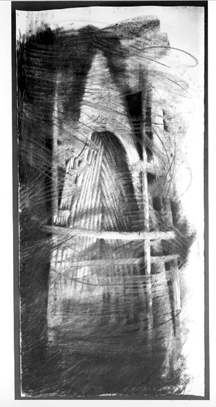

[ Metro | Metroactive Central | Archives ]
Palo Alto Triple
Ghost Vessel: Larry Thomas' 1981 charcoal-on-paper piece evokes a deeply personal nether world of the spirit.
Eye on etchings, sculpture and drawings at the Palo Alto Cultural Center
By Ann Elliott Sherman
The Palo Alto Cultural Center more than lives up to its name with three concurrent exhibitions full of divergent work, presented with a thoughtfulness that eschews any semblance of a calculated attempt to be all things to all people.
Gertrude Bleiberg's etchings are tucked away in an alcove and conference room, but the nearly animated prints refuse to be humbled by their surroundings. Shoes and handbags are elevated from mere accessories to stand-ins for their owners in character studies like "David's Boots" and "My Brown Bag." In "Annie Is Just Thirteen," persimmon, yellow and green hues, a diagonal composition and the flow of a skirt caught in a waving line capture an adolescent's hesitant progress toward womanhood.
Bleiberg's trademark humor and ability to breathe life into inanimate objects while blithely mixing angles and patterns are well displayed in an excerpt from The Wedding portfolio titled "The Cake Was Lousy." Amused perspicacity and an apparent casualness born of assured technique make Bleiberg a kind of visual Dorothy Parker.
The abstract sculptures selected for inclusion in The Essential Object share a poetic elegance. Their formal exploration of organic or utilitarian shapes, materials and technique is reductive without sacrificing all trace of heart or hand. Martin Puryear's exquisitely fitted wood sculpture, an enclosed, beveled vessel aptly titled "Sharp and Flat," epitomizes the idiosyncratic, craftsmanlike approach of the show's participating artists.
Robert Therrien's shadow box of six painted-bronze shapes is necessarily presented in a display case. That's too bad, because the smooth, palm-sized pieces--each simplified to a primary suggestion of an object like a snowman, coffin or pitcher--temptingly invite holding, play and pocketing.
David French carves and paints basswood into oddly seductive bulbs, balls and pods that evoke the kind of quizzical contemplation one might give something washed up on the shore, burnished by the elements--animal, vegetable, manmade? The sculptural effects of biological functions are given fresh wonder by Maria Fernanda Cardosa's works, which are made of actual specimens of marine life. Elongated, gently curving, celadon horns--once home to sea snails--are fit into one another and threaded into a loosely coiled spring in "Scribble," a kind of 3-D doodle.
The main attraction is the exhibition of drawings by Larry Thomas, dean of academic affairs at the San Francisco Art Institute. From the intimate, scrimshawlike silverpoint landscapes to his wall-sized pieces in charcoal and raw pigments, Thomas' explorations of Native American myth, imagination and fact filter geography and cultural history through a deeply personal lens.
The dim lighting required to preserve the works on paper accentuates the cinematic impact of the large-scale drawings, creating the sensation of entering a nether realm of the spirit. In the moody nocturne "Ghost Vessel," a partial overhead view of a canoe is paradoxically formed primarily by erasure of densely smeared charcoal, creating a now-you-see-it, now-you-don't sensation.
Thomas' chronological progression to a wide-screen mural format puts the viewer right into the vision. In "Vestige"--a close-up of stripped sticks woven into a mat or fence--a wave of emergent color goes from blues to reds on a curving diagonal, with a duskiness suggesting submersion in water or moonlight. The fencing becomes more orderly and solid in "Impediment," and reds begin to dominate Thomas' palette, until the artist's drawings are flooded with vermilion light reflecting off images of abandoned longboats partially peeled to their skeletons.
There is something familiar, yet not totally explicable, about these images. We recognize the language of dreams or a nearly forgotten past, the scene frozen from an internalized epic with an open-ended meaning. After a respite due to illness triggered by working with the toxic raw pigments, Thomas returned to large drawings with the Black Island series, where densely worked clouds of black charcoal give way to a sense of sky and water, a distant forest silhouetted by moonlight. Here, lack of definition gives a charged presence: place as a remembered feeling rather than a collection of visual details.
An unabashed romantic who clearly revels in the handmade mark, Thomas brings us into the space where the deeply personal merges with the universal.
[ Metro | Metroactive Central | Archives ] This page was designed and created by the Boulevards team.

Christopher Gardner
Gertrude Bleiberg: Etchings, The Essential Object and Larry Thomas: Drawing the Edge of the World run through April 21 at the Palo Alto Cultural Center, 1313 Newell Road, Palo Alto. (415/329-2366)
From the April 11-17, 1996 issue of Metro
Copyright © 1996 Metro Publishing and Virtual Valley, Inc.